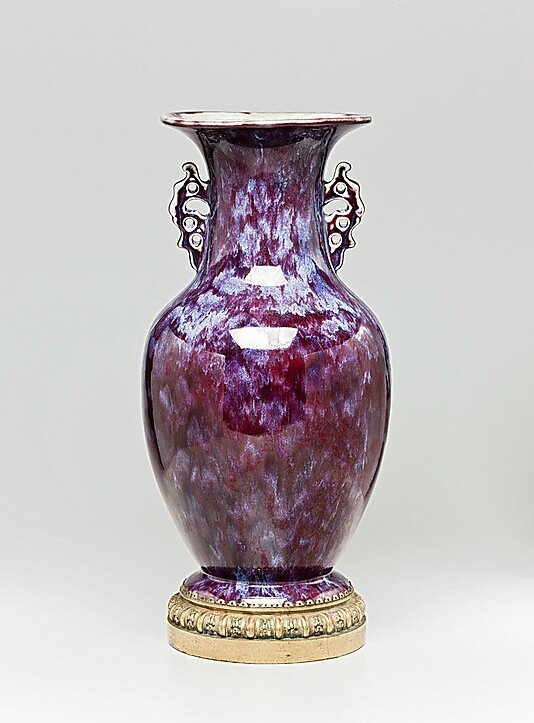Image may be NSFW.
Clik here to view.
Jean-Joseph Carriès (French, 1855–1894), Flask with face. Saint-Amand-en-Puisaye, ca. 1890. Glazed stoneware. H. 15 1/2 in.; wt. confirmed: 9.5 lb. (39.4 cm, 4.3 kg). The Metropolitan Museum of Art, Robert A. Ellison Jr. Collection, Purchase, Acquisitions Fund; Louis V. Bell, Harris Brisbane Dick, Fletcher, and Rogers Funds and Joseph Pulitzer Bequest; and 2011 Benefit Fund, 2013
NEW YORK, NY.- Making Pottery Art: The Robert A. Ellison Jr. Collection of French Ceramics (ca. 1880-1910) celebrates the recent acquisition of Mr. Ellison’s European art pottery collection at The Metropolitan Museum of Art. The majority of the 40 works on display are examples of French pottery and porcelain, and they are shown with comparative examples drawn from the Museum’s holdings of Asian art, European sculpture and decorative arts, Greek and Roman art, and European paintings to illustrate sources of inspiration.
French ceramics from Mr. Ellison’s collection of European art pottery collection include vases made by potters in the years around 1900 that pushed the boundaries of the medium and were technically experimental and aesthetically ambitious. Works by master ceramicists Ernest Chaplet, Auguste Delaherche, Pierre-Adrien Dalpayrat, and Jean Carriès are highlights of the installation. The installation also includes the monumental Vase des Binelles by Hector Guimard (who is most well-known for his Art Nouveau Métro stations throughout Paris) and an extremely rare ceramic vessel by Paul Gauguin, the first by the artist to enter the Metropolitan Museum’s collection.
Determined that pottery vessels should be regarded as true works of art, avant–garde ceramicists in France in the last decades of the 19th century transformed their craft into an intellectual and emotional endeavor. The pioneers of this revival were Jean Carriès, Ernest Chaplet, Théodore Deck, and Auguste Delaherche. These revolutionary artist-potters embraced artisanal traditions while pursuing lost techniques through exhaustive experimentation. Reacting to what they viewed as excessive and improper use of ornament, they celebrated the simplicity and sincerity of their medium, following the tenets of the Art Nouveau style taking place in Europe. Based on the principles of the British Arts and Crafts movement, Art Nouveau artists sought to reform the decorative arts by emphasizing uniqueness and a return to craftsmanship. Artist-potters found inspiration in Asian ceramics, particularly Japanese stoneware (a hard, dense type of pottery), as well as in the forms, glazes, and techniques of Chinese porcelain and pottery. They also looked to European traditions such as the rustic salt-glazed stoneware of the 16th and 17th centuries and Gothic sculpture and architecture. In the process they created works of ceramic art that were entirely modern and new.
Robert A. Ellison Jr. has been collecting pottery since the 1960s. His collection of American art pottery came to the Metropolitan Museum as a promised gift in 2009 and is currently on view in the American Wing. For his collection of outstanding European ceramics, Mr. Ellison has sought the highest-quality examples—typically on a monumental scale—by the greatest artist-potters of the late 19th and early 20th centuries to tell the narrative of the art pottery movement in Europe, especially France. In June 2013 the Metropolitan Museum acquired 76 examples of European art pottery from the Robert A. Ellison Jr. Collection, 54 of which were generously donated. These Continental and British ceramics, dating from 1867 to the 1930s, were acquired jointly by the departments of European Sculpture and Decorative Arts and Modern and Contemporary Art. The arrival of these works from The Robert A. Ellison Jr. Collection of European Art Pottery represents another ceramics milestone in the Metropolitan Museum’s history.
The installation is organized by Elizabeth Sullivan, Research Associate, with the support of Jeffrey Munger, Curator, both of the Metropolitan Museum’s European Sculpture and Decorative Arts Department.
Image may be NSFW.
Clik here to view.
Auguste Delaherche, Tall Vase. French (Paris), ca. 1893-94. Stoneware, 29 7/16 × 11 1/2 × 11 1/2 in. The Metropolitan Museum of Art, Robert A. Ellison Jr. Collection, Purchase, Acquisitions Fund; Louis V. Bell, Harris Brisbane Dick, Fletcher, and Rogers Funds and Joseph Pulitzer Bequest; and 2011 Benefit Fund, 2013.
Image may be NSFW.
Clik here to view.
Pierre-Adriene Dalpayrat (French, 1844–1910), Vase with Face. Maker: Alphone Voisin-Delacroix (Swiss, 1857–1893) French (Bourg), 1892-93. Stoneware, 25 1/2 × 16 7/8 × 16 in., 36 lb. (64.8 × 42.9 × 40.6 cm, 16.3 kg). The Metropolitan Museum of Art, Robert A. Ellison Jr. Collection, Purchase, Acquisitions Fund; Louis V. Bell, Harris Brisbane Dick, Fletcher, and Rogers Funds and Joseph Pulitzer Bequest; and 2011 Benefit Fund, 2013.
Image may be NSFW.
Clik here to view.
Ernest Chaplet (French, Sèvres 1835–1909 Choisy-le-Roi), Vase. Choisy-le-Roi, ca. 1891. Porcelain, brass; confirmed: 20 11/16 × 9 3/4 × 9 3/4 in., 18 lb. (52.5 × 24.8 × 24.8 cm, 8.2 kg). The Metropolitan Museum of Art, Robert A. Ellison Jr. Collection, Purchase, Acquisitions Fund; Louis V. Bell, Harris Brisbane Dick, Fletcher, and Rogers Funds and Joseph Pulitzer Bequest; and 2011 Benefit Fund, 2013.
Image may be NSFW.
Clik here to view.
Joseph-Théodore Deck (French, 1823–1891), Charger with birds. French, Paris, ca. 1885–90. Earthenware. Overall (confirmed): 2 3/4 × 23 7/8 × 23 7/8 in. (7 × 60.6 × 60.6 cm). The Metropolitan Museum of Art, Robert A. Ellison Jr. Collection, Robert A. Ellison Jr. Collection, Gift of Robert A. Ellison Jr., 2013
Image may be NSFW.
Clik here to view.
Paul Gauguin (French, Paris 1848–1903 Atuona, Hiva Oa, Marquesas Islands ), Vessel with Women and Goats. French, Paris, ca. 1887–89. Stoneware, confirmed, irregular diameter: 7 7/8 × 4 5/8 × 4 3/8 in., 2.2 lb. (20 × 11.7 × 11.1 cm, 1 kg). The Metropolitan Museum of Art, Robert A. Ellison Jr. Collection, Purchase, Acquisitions Fund; Louis V. Bell, Harris Brisbane Dick, Fletcher, and Rogers Funds and Joseph Pulitzer Bequest; and 2011 Benefit Fund, 2013